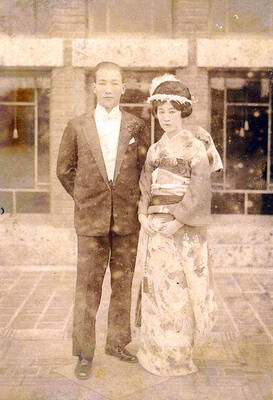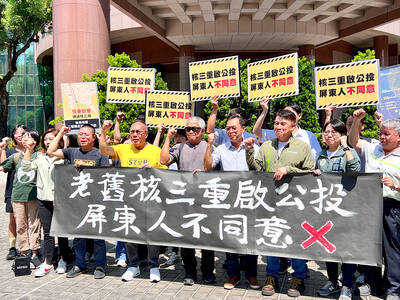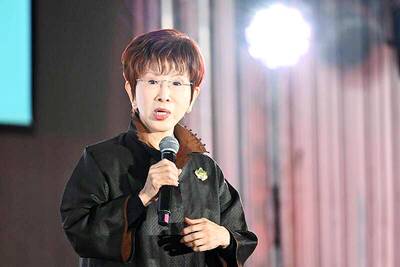Millions of Chinese students sat for notoriously tough college entrance exams yesterday, the first since the country lifted zero-COVID rules that forced classes online for months on end.
China’s education ministry says nearly 13 million students, a record, are registered to take the gaokao exams — billed by state media as the “world’s toughest” — this year.
“I’ve been waking up at 4am every day, except on Sundays, to study for the past four years,” said Jesse Rao, a 17-year-old high school senior in Shenzhen.

Photo: AFP
“I’ve done everything I can, but I still feel a bit nervous.”
In Beijing, anxious parents gathered around exam halls as their children knuckled down, many wearing red for good luck.
Zhang Jing, a mother in her forties, compared herself to Bai Suzhen, a character in Chinese folklore who is locked in a tower until her son passes an important test.
“My son is quite relaxed, I think I am more nervous than him,” said Zhang, wearing a red qipao, a traditional Chinese dress.
“I have been accompanying my son and instructing his study from the first grade of elementary school to the first year of high school,” she said.
Another mother, Fang Hong, said she had prepared a simple breakfast of bread and eggs for her son.
“My son is a bit nervous, I told him we can accept any results of the gaokao and not put any pressure on him,” she said.
‘I STRUGGLED’
Testing high school students on their Chinese, English, mathematics and other science or humanities subjects of their choice, the exams are critical to landing coveted spots at China’s top universities.
Many parents shell out hundreds of dollars a month on cram schools or hire graduate students to sit with their children while they study late into the night.
Exams are notorious for testing the ability to compose essays in response to oblique prompts, with sample questions published yesterday by the People’s Daily newspaper requiring students to contemplate the effect of technology on time management and the impact of a good story.
Another sample question asked them to muse on two aphorisms by President Xi Jinping (習近平), adding that they would be marked in part on whether they write from the “correct angle.”
Adding to the stress, this year’s exam-takers have spent the bulk of their high school years under pandemic restrictions, which ended abruptly in December.
“I struggled to follow online lessons last year,” said Katherina Wang, a high school student from Shanghai who has been through two snap lockdowns in the past two years.
“Our teachers held extra classes in the evenings and on the weekend.” The high stakes have led to elaborate attempts at cheating.
Several provinces this year have installed scanners with facial-recognition capabilities to ensure that candidates do not hire proxies to take the test on their behalf, the state-run Global Times reported.
‘I WILL TRY AGAIN’
Exams can last up to four days, depending on the province, taking between an hour and 150 minutes per subject.
The maximum score is 750, with over 600 required for a place at top-tier universities — for years a ticket to personal and professional success in China.
Very few make the cut. Last year, only three percent of exam-takers in Guangdong, China’s most populous province, scored over 600.
And for students with more modest ambitions, scores still play a critical role in securing spots in universities and what subjects can be taken.
For those that do not get the results they need, there is always next year. In 2021, 17 percent of students nationwide retook their gaokao.
“If I don’t get the results I want, I will try again,” said Benjamin Zhu, a high school senior from Guangzhou.

Sept. 1 to Sept. 7 In 1899, Kozaburo Hirai became the first documented Japanese to wed a Taiwanese under colonial rule. The soldier was partly motivated by the government’s policy of assimilating the Taiwanese population through intermarriage. While his friends and family disapproved and even mocked him, the marriage endured. By 1930, when his story appeared in Tales of Virtuous Deeds in Taiwan, Hirai had settled in his wife’s rural Changhua hometown, farming the land and integrating into local society. Similarly, Aiko Fujii, who married into the prominent Wufeng Lin Family (霧峰林家) in 1927, quickly learned Hoklo (commonly known as Taiwanese) and

The low voter turnout for the referendum on Aug. 23 shows that many Taiwanese are apathetic about nuclear energy, but there are long-term energy stakes involved that the public needs to grasp Taiwan faces an energy trilemma: soaring AI-driven demand, pressure to cut carbon and reliance on fragile fuel imports. But the nuclear referendum on Aug. 23 showed how little this registered with voters, many of whom neither see the long game nor grasp the stakes. Volunteer referendum worker Vivian Chen (陳薇安) put it bluntly: “I’ve seen many people asking what they’re voting for when they arrive to vote. They cast their vote without even doing any research.” Imagine Taiwanese voters invited to a poker table. The bet looked simple — yes or no — yet most never showed. More than two-thirds of those

In the run-up to the referendum on re-opening Pingtung County’s Ma-anshan Nuclear Power Plant last month, the media inundated us with explainers. A favorite factoid of the international media, endlessly recycled, was that Taiwan has no energy reserves for a blockade, thus necessitating re-opening the nuclear plants. As presented by the Chinese-language CommonWealth Magazine, it runs: “According to the US Department of Commerce International Trade Administration, 97.73 percent of Taiwan’s energy is imported, and estimates are that Taiwan has only 11 days of reserves available in the event of a blockade.” This factoid is not an outright lie — that

Former Chinese Nationalist Party (KMT) chairwoman Hung Hsiu-chu’s (洪秀柱) attendance at the Chinese Communist Party’s (CPP) “Chinese People’s War of Resistance Against Japanese Aggression and the World Anti-Fascist War” parade in Beijing is infuriating, embarrassing and insulting to nearly everyone in Taiwan, and Taiwan’s friends and allies. She is also ripping off bandages and pouring salt into old wounds. In the process she managed to tie both the KMT and the Democratic Progressive Party (DPP) into uncomfortable knots. The KMT continues to honor their heroic fighters, who defended China against the invading Japanese Empire, which inflicted unimaginable horrors on the